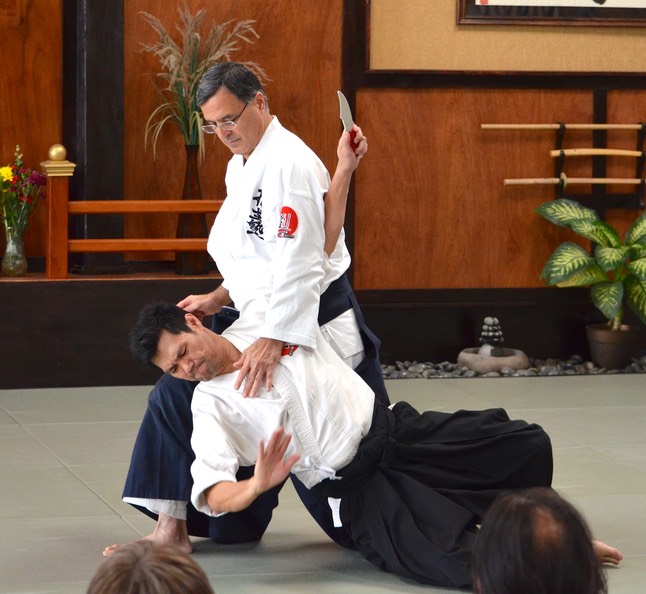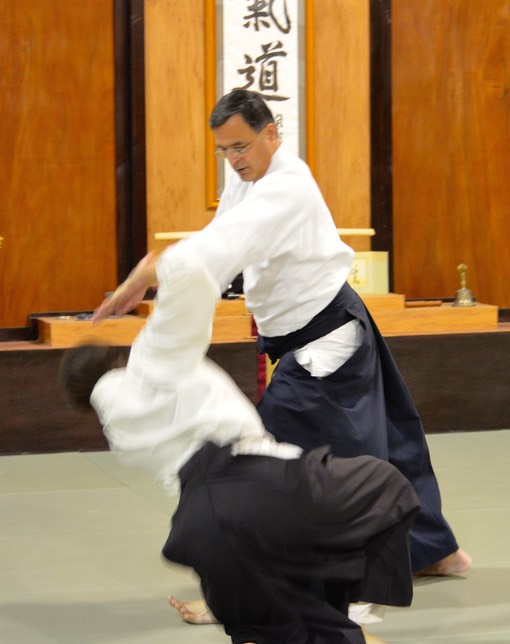"The Art of Peace does not rely on weapons or brute force to succeed; instead we attune ourselves to the Universe, maintain peace in our own realms, nurture life, and prevent destruction. The true meaning of the term samurai is one who serves and adheres to the power of love."
- Morihei Ueshiba O Sensei (1883-1969), Founder of Aikido
Aikido is an education of the mind, body and spirit: a path to the refinement of the self. Arising from the tradition of Japanese Budo (Martial Art, or Way of the Warrior: of Courageous and Enlightened Living), Aikido is also a highly practical form of self-protection. Skill in Aikido, once developed, is based on expressing universal principle and so is not restricted by size, strength or speed. This is why Aikido can be profitably practiced by people of all ages, sizes and gender.

As a highly effective form of self-defence, Aikido employs escapes, joint locks, throws, strikes or sweeps which neutralize attacks by blending with and using the attacker’s energy and intention. This is the meaning of the word “Aiki” - and it is the opposite attitude from fighting against, or overpowering, another's intention.
Aikido therefore employs minimal force: Our techniques aim to “take the fight out” of the attacker, not to destroy or to hurt more than is necessary.
What to Expect in Class:
We begin with warm-ups, breathing exercises and stretching, all expressing Aikido principles, followed by practice in safely rolling on the mat. Techniques are then practiced with partners and there is usually some solo or partner weapons work. The intensity of the class ranges from a slow, contemplative study to a challenging cardiovascular and mental workout. Class ends with cool-down stretching and breath-work.
“Practice joyfully.” - O Sensei
Training at our school is self-paced, in keeping with the individual’s age, physical condition and level of skill. Classes are conducted by senior instructors, in an atmosphere of mutual learning, safety and integrity. More experienced students are on hand to help and encourage. Students advance through belt-rank levels via a testing process for which they are given ample preparation.
The Purpose of Aikido Training:
Aikido teaches the mind to evolve beyond both aggressiveness and timidity, so as to peacefully resolve conflict without capitulation and to effectively control attacks and other dangers without excessive force: in short, to have a dignified and humane response to any life situation.
Aikido is neither a sport for winning matches, nor is it merely a collection of fighting techniques: rather it is a way of practicing fearless graciousness and balance: we use that dynamic balance as the basis, not only of self-protection, but of all our life-skills.
In keeping with its spirit of reconciliation, Aikido is a non-competitive martial art. But competition is also eschewed for the sake of safety, because Aikido deals directly with combative situations where the no rules and is not just a sport, where there are. The founder said:

“If your heart is large enough to envelope your adversaries, you can see right through them and avoid their attacks. And once you envelope them, you will be able to guide them along a path indicated to you by heaven and earth.” - Morihel Ueshiba O Sensei
The beauty and grace of Aikido has lead many observers to refer to it as “moving meditation,” “yoga in movement,” and as “the art of peace.” Its techniques exhibit harmonious and graceful movement, grounded in a strong center and presence.
As mentioned above, this practice is intended to be integrated into our everyday lives as a way of natural being, unfettered by artificial and habitual limitations. The goal of this class is to foster mental confidence, physical grace and generosity of spirit, and to learn Aiki (being in harmony with one’s situation), via technical training. Then we gain the capacity, not only to protect ourselves, but to protect and nurture the world - in whatever way is most natural.
